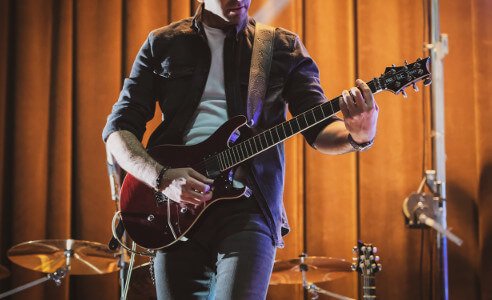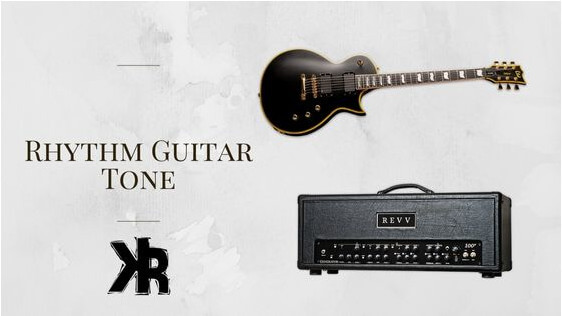Table of Contents
The rhythm guitar is one of the most important aspects of a song, but can be difficult to get right. Do you feel like your tone is suffering?
Many factors go into producing the sound you may be going after or are hearing in your head. Have you been trying the same old changes with no new results?
Depending on your music style, the settings differ greatly. Especially with all the equipment available. In this Killer Rig article, we will be looking at 5 requirements and tips to improve your rhythm guitar tone.
Quick Rhythm Tone Tips
- Boost Midrange for Presence: Enhancing the midrange frequencies can make your guitar more noticeable in the mix.
- Wah Pedal for Character: A wah pedal can bring a dynamic touch to your rhythm guitar playing.
- Vary Strumming and Chords: Mixing up your strumming patterns and chord choices can enrich your rhythm guitar work.
- High Gain, Low Volume: Amp up the gain for a grittier tone, but keep the volume in check to not drown out the rest of the mix.
- Play with Pedals: Utilize effects like overdrive, distortion, and compression to diversify your tone.
- Choose the Right Guitar: Different guitars offer varied tones; try out multiple options to find what complements your style.
- Fine-Tune Your EQ: Adjust the bass, mid, and treble settings on your amp or effects pedal to achieve the ideal tone for your performance.
1. The Right Guitar For Rhythm
The first thing you will need to consider is your guitar. If you are playing rhythm, this is one of the most significant factors in getting a great tone. What kind of music you are playing? Different guitars will work better than others.
For instance, if you are playing heavy metal music, you might need a 7-string electric guitar. Depending on how much thicker the sound should be. For blues, you might look for a hollow body with thinner strings to match your tone.
Rhythm guitars play a huge role in determining the tone of your music. You will need to experiment with different models depending on what kind of gear you are using.
Are you playing a Stratocaster and wondering why you cannot get a good thick high gain sound? This is because it’s the wrong instrument.
Proper Use of Pickups
Most electric guitars that are designed for a certain type of music will come with the right pickups. This allows a guitarist to simply start using it for the style that they play. Yet, different sounds can be obtained by setting the selector switch.
While some switches are marked rhythm, like on a Les Paul, the truth is, it doesn’t matter which you use. You will hear and read that you should use a setting for a certain sound. This has its place. The truth is, you should use the setting that best matches your electric guitar rhythm tone.
The neck pickup will be warmer and so for certain styles of music, this will be perfect! But for others, it might be too bass-heavy and not as tight as you need. And so use the setting that sounds best for your needs.
Just remember that the pickup sounds are:
- Neck pickup: warm sounding
- Bridge pickup: brighter sounding
2. The Amplifier
The next thing you will need to consider is your amp. Many times, people assume that all amps are the same, and so they just grab the cheapest one that they can find. And this is fine if all you want to do is practice at home.
But when it comes to playing out live on stage. Either with a band or recording in a studio, that cheap amp is probably not going to get you a great tone. Rhythm guitarists are one of the most important factors for your band. And so you need to make sure that gear is top-notch!
If you are going for a classic rock rhythm, then you need to make sure to be using the right amplifier. Every design has a certain sound in mind.
If you get something that is scooped in the mid-range, make sure your style of music supports this. Otherwise, you might be missing some essential frequencies in your rhythm tone.
Amp Heads or Modelers
The first thing you need to decide on is whether you will use an amp head, combo, or digital modeler. Amps come in two different styles: heads and combos. Amp Heads are stand-alone units that need speaker cabinets. Combos combine both the amplifier head and speaker all in one unit!
Modelers can also come in the same types of layouts as a tube amp for example and can also be a good choice. This depends on the quality of the models, of course.
But make sure your choice will support the music style you play. Are you looking for a rhythm tone that needs to be loud and heavily saturated? A 20-watt combo amplifier might be the wrong choice.
3. Dialing in Your Rhythm Tone
Once you have your amplifier and electric guitar, it’s time to dial in your tone presets. Rhythm instruments are used as the foundation of the music, so it’s important that this part be done right!
First, make sure you’ve got your volume set correctly. On both your electric guitar and amplifier. You will need to experiment with these knobs individually to find what is best for you. But first, get your equalization set right.
Now it’s time to shape your sound with the tone knobs. This part is up to personal preference, so no one right answer exists here.
You have to experiment until you find something that sounds good for what you do. If you have the perfect guitar and amp, then it should only require some light tweaking.
The treble and mids are worth mentioning as they are some very important controls. A rhythm play needs to have a sound that is not too boomy, so these control can help. Adjust your controls until the sound is supportive but also cuts through the mix, but also isn’t too bright.
You don’t want to overshadow the lead player, so a properly dialed-in sound for rhythm is very important.
Be sure to also consider your pickup selection and the setting of the guitar tone knob. These features exist to help you get a great rhythm tone. Be sure to use them as well.
MidRange Settings
A great example of where midrange is important for rhythm tone is AC/DC’s Thunderstruck. You will notice that both parts use almost only the same notes. But Angus uses a higher output pickup and cranks his amp to achieve a distinct tone.
The rhythm part uses a lower output pickup and has the midrange dialed up between 8 and 10.
This works because it gives more weight and beefiness to the part. Without adding too much of the higher frequencies. This allows for maximum clarity and articulation in the rhythm tone. And even though this tonal difference is subtle, it makes a big difference!

4. Rhythm Effects
Effect pedals can be used to add that special touch to your rhythm guitar parts. An overdrive pedal in particular works well because it helps fill out the sound. It add a bit of extra grit, which makes you stand out from the other instruments.
The idea here is not to make the part complicated or flashy, it’s to be meaningful.
Some of the suitable effects that you might want on a rhythm tone pedal board are:
- Overdrives
- Boost
- Compressor
- Chorus
- Reverb
- Delay
A tuner and volume pedal can also be a great idea, depending on your role in the group or the style of music that is played.
Some players also prefer to run a distortion pedal into a clean amp to get their heavy tones. So many great-sounding distortions on the market. This is also a very good way of finding different tones.
5. Skill
Last but not least, you will want to think about your playing method. Rhythm guitarists are always looking for a way to stand out. Especially from the other instruments in the band. Like the drummer or bassist, so developing a unique style of play is one surefire way to do that.
Even if it’s something as simple as strumming with a different beat or rhythm, it will help your parts stand out.
It’s also very important to be well-rehearsed and knowledgeable. Make sure to know many chords and their root notes. Part of creating great rhythm sounds is to be able to assemble riffs based on the right notes.
Sometimes it’s easy to blame our equipment when it doesn’t sound good. But it’s also possible that the technique is not right. Some players say that tone is in the fingers, and that is correct in some situations.
Conclusion
Having a great performance is about more than knowing which effects to use. Most sounds need clarity, power, and precision. These elements all start with the right setup and choosing the correct gear for your style of music.
Once you have all that and the proficiency behind you, a great rhythm guitar tone will be yours for the taking!
FAQs
What is Rhythm Guitar?
Rhythm guitar refers to a play style in a musical setting. It’s the foundation of a song and is usually much more than just strumming chords. Rhythm guitar can add harmony to other parts. It can introduce new musical ideas, and it can provide accents during important moments in a song.
This is usually done with both electric and acoustic guitars. All depends on the music type and needs.
Why is Rhythm Guitar Hard?
Most players who are struggling to learn rhythm are normally newer guitarists. With a bit of practice and an increase in dexterity, this will become easier. It’s best to work on things that keep you motivated to play. This way you will not burn out with new challenges.
Any new skill or task will normally be hard in the beginning. But as you work towards your goals, things will begin to slowly become easier.

